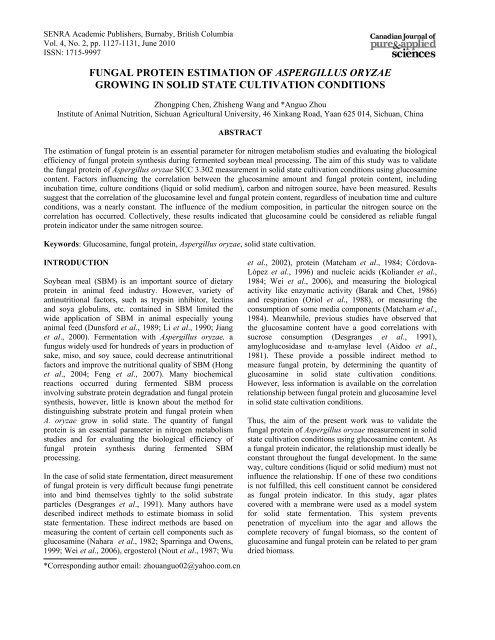Download (5Mb) - Covenant University Repository
Download (5Mb) - Covenant University Repository
Download (5Mb) - Covenant University Repository
Create successful ePaper yourself
Turn your PDF publications into a flip-book with our unique Google optimized e-Paper software.
SENRA Academic Publishers, Burnaby, British Columbia<br />
Vol. 4, No. 2, pp. 1127-1131, June 2010<br />
ISSN: 1715-9997<br />
FUNGAL PROTEIN ESTIMATION OF ASPERGILLUS ORYZAE<br />
GROWING IN SOLID STATE CULTIVATION CONDITIONS<br />
Zhongping Chen, Zhisheng Wang and *Anguo Zhou<br />
Institute of Animal Nutrition, Sichuan Agricultural <strong>University</strong>, 46 Xinkang Road, Yaan 625 014, Sichuan, China<br />
ABSTRACT<br />
The estimation of fungal protein is an essential parameter for nitrogen metabolism studies and evaluating the biological<br />
efficiency of fungal protein synthesis during fermented soybean meal processing. The aim of this study was to validate<br />
the fungal protein of Aspergillus oryzae SICC 3.302 measurement in solid state cultivation conditions using glucosamine<br />
content. Factors influencing the correlation between the glucosamine amount and fungal protein content, including<br />
incubation time, culture conditions (liquid or solid medium), carbon and nitrogen source, have been measured. Results<br />
suggest that the correlation of the glucosamine level and fungal protein content, regardless of incubation time and culture<br />
conditions, was a nearly constant. The influence of the medium composition, in particular the nitrogen source on the<br />
correlation has occurred. Collectively, these results indicated that glucosamine could be considered as reliable fungal<br />
protein indicator under the same nitrogen source.<br />
Keywords: Glucosamine, fungal protein, Aspergillus oryzae, solid state cultivation.<br />
INTRODUCTION<br />
Soybean meal (SBM) is an important source of dietary<br />
protein in animal feed industry. However, variety of<br />
antinutritional factors, such as trypsin inhibitor, lectins<br />
and soya globulins, etc. contained in SBM limited the<br />
wide application of SBM in animal especially young<br />
animal feed (Dunsford et al., 1989; Li et al., 1990; Jiang<br />
et al., 2000). Fermentation with Aspergillus oryzae, a<br />
fungus widely used for hundreds of years in production of<br />
sake, miso, and soy sauce, could decrease antinutritional<br />
factors and improve the nutritional quality of SBM (Hong<br />
et al., 2004; Feng et al., 2007). Many biochemical<br />
reactions occurred during fermented SBM process<br />
involving substrate protein degradation and fungal protein<br />
synthesis, however, little is known about the method for<br />
distinguishing substrate protein and fungal protein when<br />
A. oryzae grow in solid state. The quantity of fungal<br />
protein is an essential parameter in nitrogen metabolism<br />
studies and for evaluating the biological efficiency of<br />
fungal protein synthesis during fermented SBM<br />
processing.<br />
In the case of solid state fermentation, direct measurement<br />
of fungal protein is very difficult because fungi penetrate<br />
into and bind themselves tightly to the solid substrate<br />
particles (Desgranges et al., 1991). Many authors have<br />
described indirect methods to estimate biomass in solid<br />
state fermentation. These indirect methods are based on<br />
measuring the content of certain cell components such as<br />
glucosamine (Nahara et al., 1982; Sparringa and Owens,<br />
1999; Wei et al., 2006), ergosterol (Nout et al., 1987; Wu<br />
*Corresponding author email: zhouanguo02@yahoo.com.cn<br />
1147<br />
et al., 2002), protein (Matcham et al., 1984; Córdova-<br />
López et al., 1996) and nucleic acids (Koliander et al.,<br />
1984; Wei et al., 2006), and measuring the biological<br />
activity like enzymatic activity (Barak and Chet, 1986)<br />
and respiration (Oriol et al., 1988), or measuring the<br />
consumption of some media components (Matcham et al.,<br />
1984). Meanwhile, previous studies have observed that<br />
the glucosamine content have a good correlations with<br />
sucrose consumption (Desgranges et al., 1991),<br />
amyloglucosidase and α-amylase level (Aidoo et al.,<br />
1981). These provide a possible indirect method to<br />
measure fungal protein, by determining the quantity of<br />
glucosamine in solid state cultivation conditions.<br />
However, less information is available on the correlation<br />
relationship between fungal protein and glucosamine level<br />
in solid state cultivation conditions.<br />
Thus, the aim of the present work was to validate the<br />
fungal protein of Aspergillus oryzae measurement in solid<br />
state cultivation conditions using glucosamine content. As<br />
a fungal protein indicator, the relationship must ideally be<br />
constant throughout the fungal development. In the same<br />
way, culture conditions (liquid or solid medium) must not<br />
influence the relationship. If one of these two conditions<br />
is not fulfilled, this cell constituent cannot be considered<br />
as fungal protein indicator. In this study, agar plates<br />
covered with a membrane were used as a model system<br />
for solid state fermentation. This system prevents<br />
penetration of mycelium into the agar and allows the<br />
complete recovery of fungal biomass, so the content of<br />
glucosamine and fungal protein can be related to per gram<br />
dried biomass.

















